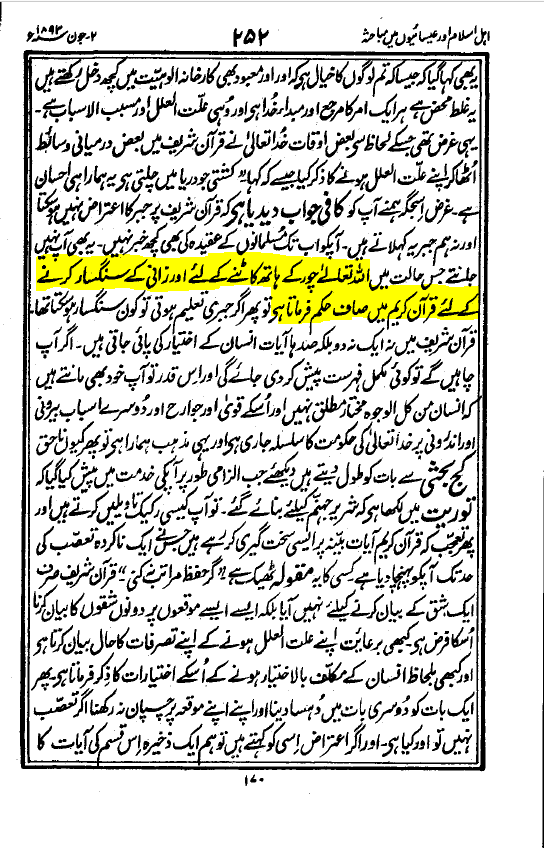بِسْمِ اللَّـهِ الرَّحْمَـٰنِ الرَّحِيمِ
In a previous post we
examined how the Barelwis justified the incident of Shaikh Abu Bakr Shibli
asking his potential disciples to recite a new Kalimah: لا الـه الا الله, شبلى رسول الله “There is none worthy of
worship save Allah; Shibli is the Messenger of Allah”. The Barelwi scholar
Maulana Shah Gul Hasan justified the uttering of this apparent statement of Kufr:
بات یہ تھی کہ جو شخص تعلیم و تلقین اور ہدایت و ارشاد کرتا
ہے طالب کے لیے وہی رسول ہے اور رسالت الہی کا کام انجام دیتا ہے۔
“That person
who teaches, preaches, and guides is a Rasul for the disciple, and
carries out the function of being God’s Messenger.” (Tazkirat-e-Ghausiya; p.324)
Another a Barelwi scholar, “Qutb
ul Aqtab” Khwajah Qutb Uddin Bakhtiar Kaki, in his book Fawaid-us-Salikin,
mentions a similar incident concerning Hadrat Mu’in Uddin Hasan Chishti
(popularly known as “Gharib Nawaz” whose tomb is in Ajmer, India) where a
prospective disciple was asked to say and did say a new Kalimah:
لا الـه الا الله, چشتى رسول الله
ایک شخص باہر سے
آیا اور بیعت ہونے کی نیت سے خواجہ صاحب کے قدموں میں سر رکھ دیا۔ آپ نے فرمایا
بیٹھ جا۔ وہ بیٹھ گیا اور اس نے عرض کی کہ میں آپ کی خدمت میں مرید ہونے کے واسطے
آیا ہوں! شیخ صاحب اس وقت اپنی خاص حالت میں تھے۔ آپ نے فرمایا کہ جو کچھ میں تجھے
کہتا ہوں وہ کہو اور بجالا تب مرید کروں گا۔ اس نے عرض کی کہ جو آپ فرمائیں میں
بجالا نے کو تیار ہوں۔ آپ نے فرمایا کہ تو کلمہ کس طرح پڑھتا ہے؟ اس نے کہا لا الہ الا اللہ محمد رسول اللہ۔ آپ نے فرمایا یوں کہو!
لا الہ الا اللہ چشتی رسول اللہ۔ اس نے
اسی طرح کہا۔ خواجہ صاحب نے اسے بیعت کرلیا اور خلعت و نعمت دی اور بیعت کے شرف سے
مشرف کیا پھر اس شحص کو فرمایا کہ سن! میں نے تجھے جو کہا تھا کہ کلمہ اس طرح
پڑھو! یہ صرف تیرا عقیدہ آزمانے کی خاطر کہا تھا ورنہ میں کون ہوں؟ میں تو ایک
ادنی سا غلام محمد رسول اللہ صلی اللہ علیہ وسلم کا ہوں۔ کلمہ اصل میں وہی ہے لیکن
میں نے صرف حال کی کمالیت کی وجہ سے یہ کلمہ تیری زبان سے کہلوایا تھا چونکہ تو
مرید ہونے کیلئے آیا ہے اور تجھ پر یقین کامل تھا۔ اس لئے فورا تو نے ایسا کہہ
دیا اس لئے سچا مرید ہوگیا۔ اور در حقیقت مرید کا صدق بھی ایسا ہی ہونا چاہۓ کہ
اپنے پیر کی خدمت میں صادق اور راسخ رہے۔
Translation: A person from
abroad came with the intention of giving the Bay’ah (pledge of
allegiance) to Khwajah sahib [Pir Mu’in Uddin Hasan Chishti] and placed his
head between Khwajah’s feet. Khwajah sahib said: “Sit down”. He sat down and
said: “I have come to you for the purpose of becoming your disciple”. At the
time Shaikh [Chishti] was in his particular [spiritual] state and said: “Whatever
I say to you repeat it, only then I will make you into my disciple”. The man
said: “I am ready to repeat whatever you tell me to say”. Khwajah sahib asked: “How
do you read the Kalimah?” The man said: “La elaha illa Allah,
Muhammad Rasul Allah”. Khwajah sahib said: “Say like this: La elaha illa
Allah, Chishti Rasul Allah”. The man said it like that. Khwajah sahib then
accepted his Bay’ah and furthermore honored him with a gift and with the
proximity of companionship. Then he said to that man: “Listen! When I told you
to read the Kalimah like this, it was only for the sake of testing your aqidah,
otherwise who am I? I am just an insignificant slave of Muhammad the Messenger
of Allah peace be upon him. In reality that is the Kalimah, but I only made you
recite this other Kalimah on your tongue because you came for the purpose of
becoming a disciple and you possess perfect certitude. That is why you
immediately repeated what I told you to say and became a true disciple. And in
reality a disciple’s sincerity should be like this; he should be sincere to his
Pir (spiritual guide) and cling to him.”
Reference:
Fawaid-us-Salikin; p.23
This citation from a
Barelwi text is highly problematic for a number of reasons. Firstly, while
Khwajah Chishti was apparently testing his prospective disciple, by
accepting the man’s Bay’ah and rewarding him, it becomes clear that the
disciple in fact passed the test; whereas according to the principles of
Islam the man failed the test and should have been rejected by any true Saint
or Guide. When asked to say a Kalimah of Kufr, a true Believer would not repeat
that Kalimah but instead refuse to do so thereby demonstrating his faithfulness
to Islam. However, Khwajah Mu’in Uddin Chishti (according to this story)
revealed the fact that the purpose of the test was to determine the extent to
which the man was willing to blindly follow him, which is why he stated that a
disciple should be like that and cling to his Pir with such fanaticism
and blindness. This shows the grave error of the Barelwis and their extreme
form of Sufism in blindly following a Pir and showing greater loyalty to
him over and above the teachings of the Islamic Faith and Shari’ah. I conclude
that it is in fact the Barelwis who are opposing the principle of Khatam
an-Nubuwwah (Finality of Prophethood) by teaching people to give precedence
to their Sufi guides over and above the Prophet (ﷺ).





















